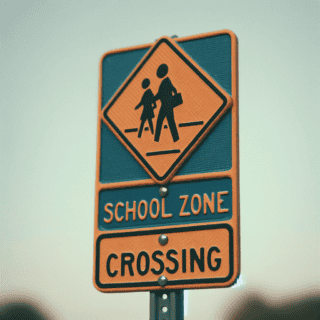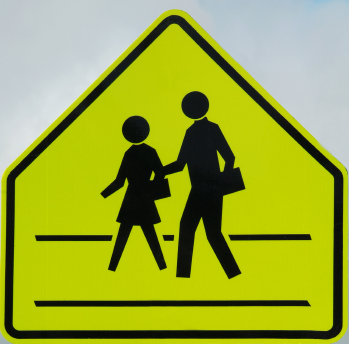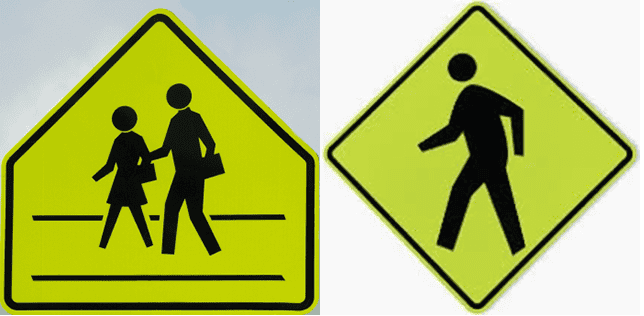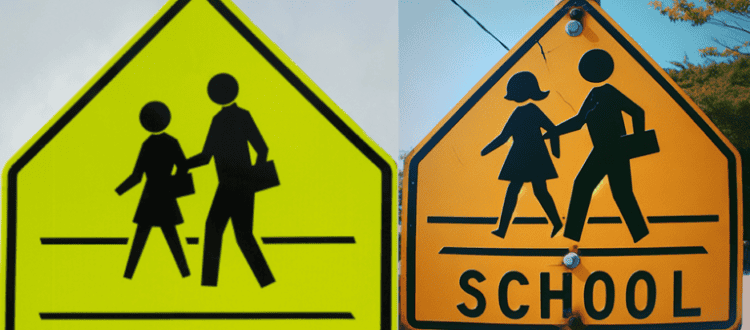The School Zone Crossing Sign is a vital component of road safety in areas surrounding educational institutions. This distinctive sign serves as a visual warning to drivers, indicating that they are entering a zone where children may be crossing the street.
The sign typically features a symbolic image of a school building and a group of children, alerting drivers to reduce their speed and exercise caution. It is also combined with white-painted pavement markings to show students where to walk and cars where NOT to drive when students are on the crosswalk. The sign’s bright, fluorescent yellow-green diamond grade sheeting and bold design make it easily recognizable, effectively communicating the need for heightened vigilance. It plays a crucial role in ensuring the safety of students and pedestrians, reminding motorists to be mindful of their surroundings and prioritize the protection of young lives.
What Is a School Zone Crossing Sign Indicative Of?
 The School Zone Crossing Sign serves as a clear signal to drivers that they are entering an area where children are likely to be present, particularly during school hours. This sign is a visual reminder for motorists to reduce their speed, be extra vigilant, and be prepared to stop for all pedestrians crossing the street.
The School Zone Crossing Sign serves as a clear signal to drivers that they are entering an area where children are likely to be present, particularly during school hours. This sign is a visual reminder for motorists to reduce their speed, be extra vigilant, and be prepared to stop for all pedestrians crossing the street.
It indicates that the safety of children is of paramount importance and that drivers should exercise caution to prevent accidents and ensure the well-being of young students. It is a crucial communication tool, effectively conveying the need for increased awareness and attentiveness while driving through school zones.
Do School Zone Crossing Signs Need to be MUTCD-Compliant?
Yes, they are required to be MUTCD (Manual on Uniform Traffic Control Devices) compliant. The MUTCD sets the national standard for all traffic control devices, including signs, signals, and pavement markings. By adhering to MUTCD guidelines, School Zone Crossing Signs ensure consistency and uniformity in their design, placement, and visibility, thereby enhancing their effectiveness in communicating important safety information to drivers. Compliant signs are crucial for promoting road safety and reducing the risk of accidents in school zones, as they are designed to meet specific criteria for size, color, and placement, enabling them to effectively convey their message to motorists.
What Material is a School Zone Crossing Sign Made of?
They are made of diamond grade reflective sheeting overlaid on aluminum or aluminum alloy. The use of aluminum as the primary material ensures that the sign is lightweight yet durable, able to withstand various weather conditions and remain highly visible both during the day and at night. The reflective properties of the aluminum allow the sign to be easily seen in low light conditions or when illuminated by headlights, further enhancing its effectiveness in alerting drivers to the presence of a school zone. Also, the use of aluminum makes the sign resistant to corrosion, ensuring its longevity and reliability in serving its crucial role in promoting road safety.
Do School Zone Crossing Signs Need to be Reflective?
Yes, they need to be ultra-reflective to ensure optimal visibility, especially during low-light conditions. The reflective properties of these signs allow them to be easily seen by drivers, even at night or in adverse weather. By using reflective materials, the signs enhance safety by alerting motorists to the presence of a school zone and the likelihood of children crossing the street. This reflective feature plays a critical role in reducing the risk of accidents and promoting overall road safety in these areas.
Shape, Location and Color
Shape and Color
The School Zone Crossing Sign typically features a “pentagon” shape, which is used exclusively for school zone signs. This shape provides a clear and familiar visual cue to drivers, allowing for quick recognition and comprehension of the sign’s message. The rectangular format also allows for the inclusion of easily recognizable symbols and text, such as depictions of children with school books, contributing to the sign’s effectiveness in communicating important safety information to motorists.
Location
 School Zone Crossing Signs should be strategically placed at the beginning of the school zone to provide ample warning to drivers that they are entering an area where children may be present. Additionally, signs should be positioned at regular intervals throughout the school zone to maintain driver awareness and reinforce the reduced speed limit.
School Zone Crossing Signs should be strategically placed at the beginning of the school zone to provide ample warning to drivers that they are entering an area where children may be present. Additionally, signs should be positioned at regular intervals throughout the school zone to maintain driver awareness and reinforce the reduced speed limit.
Placing these signs at a consistent height and distance from the road allows for clear visibility and ensures that drivers have adequate time to adjust their speed and be alert for potential pedestrian crossings. Proper placement is essential for effectively communicating the need for increased caution and adherence to reduced speed limits in school zones.
Are Fluorescent School Crossing Signs Better than Regular Reflective Ones?
Fluorescent School Crossing Signs offer enhanced visibility during both daytime and nighttime, making them particularly effective in alerting drivers to the presence of a school zone. The vibrant fluorescent colors, such as fluorescent yellow-green, stand out against the surrounding environment, increasing the likelihood of attracting the attention of motorists. Also, fluorescent signs are known for their ability to remain conspicuous in low-light conditions and adverse weather, further contributing to their effectiveness in promoting road safety. By providing superior visibility, fluorescent school crossing signs play a crucial role in reducing the risk of accidents and ensuring the safety of pedestrians, especially in school zones.
 Regular reflective school crossing signs are designed to be visible at night when illuminated by headlights, but may not be as effective as the diamond grade fluorescent yellow green signs – according to MUTCD regulations – in attracting immediate attention during the day. Fluorescent school crossing signs, on the other hand, offer enhanced visibility during both daytime and nighttime, making them particularly effective in alerting drivers to the presence of a school zone.
Regular reflective school crossing signs are designed to be visible at night when illuminated by headlights, but may not be as effective as the diamond grade fluorescent yellow green signs – according to MUTCD regulations – in attracting immediate attention during the day. Fluorescent school crossing signs, on the other hand, offer enhanced visibility during both daytime and nighttime, making them particularly effective in alerting drivers to the presence of a school zone.
The vibrant fluorescent colors, such as the aforementioned DG Fluorescent Yellow-green, stand out against the surrounding environment, increasing the likelihood of attracting the attention of motorists. Also, fluorescent signs are known for their ability to remain conspicuous in low-light conditions and adverse weather, further contributing to their effectiveness in promoting road safety. By providing superior visibility, fluorescent school crossing signs play a crucial role in reducing the risk of accidents and ensuring the safety of pedestrians, especially in school zones.
Are School Zone Crossing Signs Sturdy Enough for Long Term Use?
They are designed to be sturdy and durable, capable of withstanding long-term use in various weather conditions. Typically constructed from materials such as reflective-sheeted aluminum or aluminum alloy, these signs are resistant to corrosion, ensuring their longevity and reliability. Their robust feature enables them to endure the rigors of outdoor exposure, including exposure to sunlight, rain, and snow, without compromising their structural integrity. These signs are engineered to withstand the elements and remain highly visible and effective in promoting road safety for an extended period, making them a dependable and long-lasting solution for marking school zones.
Is there a Difference between School Crossing and Pedestrian Crossing Signs?
The primary difference between School Crossing and Pedestrian Crossing signs lies in their intended purpose and location. School Crossing signs are specifically placed near schools where children are likely to be crossing the road, serving as a warning to drivers to exercise caution and be prepared to stop for students. These signs often feature specific school-related symbols, such as images of children with backpacks, to emphasize the presence of young pedestrians.

On the other hand, Pedestrian Crossing signs are more general in nature and can be found at any designated crosswalk or intersection where pedestrians may be crossing. They serve as a reminder to drivers to yield to pedestrians and are not necessarily associated with school zones. While both types of signs aim to enhance pedestrian safety, School Crossing signs are tailored to alert drivers to the unique hazards present in school areas, while Pedestrian Crossing signs serve as a reminder to yield to pedestrians in various urban and suburban locations.
Conclusion
A School Zone Crossing Sign plays a pivotal role in promoting road safety by effectively alerting drivers to the presence of school zones and the potential for pedestrian crossings, especially by children. It is strategically placed to provide ample warning to motorists as they enter school zones and are designed to withstand long-term use in various weather conditions. Its sturdy, distinct design, and clear messaging make it a crucial component of traffic management, contributing to the overall safety of school areas and the surrounding roadways.
Popular Posts:




